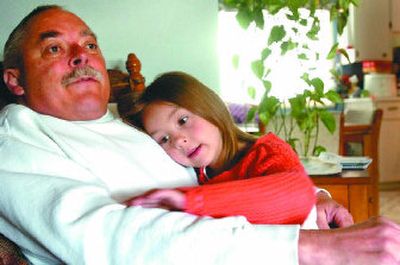Keeping up with disease

Of the 784 people diagnosed with invasive breast cancer in Idaho two years ago, 10 were men – and Dave Shaw was one of them. The Coeur d’Alene retiree still shakes his head at the odds of developing a disease that affects far more women than men, by a national ratio of 100-to-1. But it’s not that Shaw, 58, is squeamish or shy about the kind of cancer he has.
“A lot of men are ashamed of it,” he said. “If you’ve got cancer, you’ve got cancer. Let’s deal with it.”
Just as surprising as Shaw’s rare diagnosis has been the realization that so many of his North Idaho friends and neighbors are grappling with cancer of all kinds.
“It’s amazing,” said Shaw, who underwent surgery and chemotherapy treatment starting in 2005 at Kootenai Medical Center’s North Idaho Cancer Center. “You see little kids to people in their 80s.”
That’s a fact not lost on KMC officials, who are weeks away from opening a long-sought $1.1 million satellite cancer center in Sandpoint and on the verge of planning an estimated $10 million expansion in Post Falls.
The number of new cancer cases in the five North Idaho counties jumped by 52 percent – from 728 to 1,104 – in the decade between 1995 and 2005, according to new figures from the Cancer Data Registry of Idaho. The statewide figure was 36 percent for the same time period.
Even adjusting for regional population growth, the North Idaho cancer rate per 100,000 residents grew by almost 20 percent that decade, higher than the 12 percent rate for the entire state.
That’s partly because population has grown faster in the state’s northern counties – 27 percent locally; 21 percent statewide – and partly because the North Idaho population is generally older, state and local officials said.
Whatever the cause, those numbers represent an urgent need for more space and more services at a hospital now caring for 210 cancer patients each day, said Lisa Johnson, spokeswoman for KMC.
“Cancer is now becoming a chronic disease,” she said. “You learn to live with it.”
As patients are living longer – and better – lives, KMC has worked to expand treatment, especially for far-flung patients, officials said. On June 1, they’ll open the doors of a new 4,600-square-foot clinic housed within Bonner General Hospital in Sandpoint, increasing availability from three days a week to five.
“We sometimes have 10 to 15 people a day for chemo and another 10 to 15 a day for follow-up,” said Judy Nespeca, the hospital executive hired last fall to direct cancer center operations.
Offering cancer patients and their families an alternative to a 90-mile drive – or more – was the impetus for the center.
“We did a survey that showed 25 percent of patients came from Sandpoint north,” said Don Soltman, KMC’s vice president for support services.
That included patients from the farthest corners of Bonner and Boundary counties, but also from Montana, he said.
The increased hours will be welcome, said Katie Littlefield, 83, of Sandpoint. Her husband, Gene Littlefield, 85, expected the expanded center to open last fall, based on hospital officials’ original plans. But the pair will be grateful for more time and space now.
“It will mean a whole lot to a lot of people,” Katie Littlefield said Tuesday.
Equally pressing is the need for more space and services in Kootenai County, said Nespeca. With nearly 1,000 new cancer cases diagnosed last year, resources from parking to bed space are at a premium.
“Sometimes when you come, you see our waiting rooms are coming out the doors,” she said.
Kootenai Hospital District board members last week agreed to ask Seattle architectural firm Mithun to proceed with plans for a new cancer center on 10 acres at 1300 Mullan Ave. in Post Falls.
Plans call for a 15,000- to 20,000-square-foot center that could cost upward of $10 million. Still uncertain is what services might be included. Radiation therapy, for instance, would boost the price tag to accommodate expensive equipment such as a linear accelerator, Soltman said.
So far, patients said, the exponential growth in cancer care hasn’t hurt their treatment. Sandpoint clinic staff members do a good job of scheduling clients and keeping things running smoothly, Katie Littlefield said.
And in Coeur d’Alene, Dave Shaw couldn’t have been more pleased with his cancer treatment.
Two years ago Shaw’s granddaughter, Ashley Webler, 6, noticed something funny about his chest. Shaw pointed out an inverted nipple to a medical technician and also asked about a marble-sized lump on his left side.
Less than a week later, Shaw underwent a mastectomy and removal of 18 cancer-infected lymph nodes. More than a year of chemotherapy later, the disease appears to be in check, thanks, he said, to the treatment he received at KMC.
“That cancer center is just fantastic,” he said.